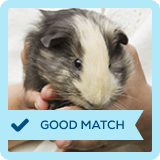Average Bird Lifespans
Jacque Lynn Schultz, C.P.D.T., Companion Animal Programs Adviser.
Photo Credit: Thinkstock[/caption]

A lifetime commitment to a bird may be longer than you imagined. For years, bird care was seen as little more than keeping the seed cup full, the water fresh and the cage clean. But as we learn more about birds’ needs and begin to meet those needs, our avian companions are living longer than ever.
Once, avian diets consisted only of seeds. When offered seed mixes, many birds went right to dessert – the sunflower seeds. They quickly packed on the pounds …er, ounces, making birds old and unhealthy before their time. Current avian diet recommendations call for a top quality pelleted food along with small portions of fresh fruits and vegetables, nuts, legumes and some starches in the form of pasta, whole grains, and cooked brown rice, depending on the species, with seeds relegated to treat status. A well-written breed-specific book about your type of bird will give you more specific feeding directions.
Suitable housing is important to bird welfare as well. While the ornate cages of the Victorian era are most decorative, they’re more suitable for plants than birds. Birds need space to flap their wings, glide from perch to perch, and climb all around. Since small birds like finches and canaries are rarely allowed free flight around the home for safety reasons, they also need enough space to fly. Because of their small size, canaries and finches could also be offered free flight in a small, bird safe room, for supervised out-of- cage time. Buy as big a cage as space and resources allow. Keep in mind that bar spacing must be adequate for the size of your bird -- or birds. Here are some guidelines: small birds (canaries – lovebirds) 3/8” – 7/16”, medium birds (cockatiels – small parrots) ½” – ¾”, Large birds (amazons – African greys) ¾” – 1”, and very large birds (cockatoos, macaws) ¾” – 1-1/2” between the bars needed. Caging materials should be very sturdy and free of lead and zinc.
A larger cage allows for more in-cage exercise and has more room for toys. Brainy birds enjoy dismantling puzzle toys and untying knots. Toys should be size appropriate and made of bird-safe materials. Rotate them to keep the bird’s interest. And don’t forget that birds budgie-sized and larger need daily exercise time out of the cage in order to stay both physically and mentally fit.
As flock creatures, most birds are happier with a suitably- sized companion bird or one of its own species. But before bringing home that second bird and introducing him to your resident bird, quarantine him in a separate room until you get a clean bill of health from your avian veterinarian. He or she may recommend a 14-30 day isolation period before allowing them to share the same space.
With safe housing, proper nutrition, veterinary care, and plenty of mental and physical stimulation, how long could your bird’s life be?
- Canaries average 8-16 yrs., 20-30 yrs. possible
- Finches average 3-6 yrs., more than 20 yrs. possible
- Budgies average 8 yrs., 20 yrs. possible
- Lovebirds average 8-12 yrs., 20 yrs. possible
- Conures average 10-20 yrs., 40 yrs. possible
- Amazons average 20-30 yrs., more than 50 yrs. possible
- Cockatoos average 25-40 yrs., more than 80 yrs. possible
- Macaws average 25 yrs. (small)/40 years (large), 40 yrs. /80 yrs. possible
- Don’t forget to include a provision for the birds in your will as they just might outlive you! Check out the Petfinder Library for articles on setting up a pet trust and then enjoy every minute of life with your avian companions.